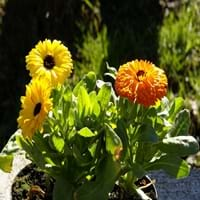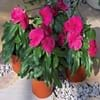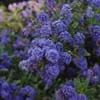Life Span
Perennial
Perennial
Type
Shrub
Flowering Plants
Origin
Russia/Siberia, China
Europe, Mediterranean
Types
Dwarf Siberian Peashrub, Sutherland Peashrub, Weeping Siberian Peashrub
Kablouna Gold, Fiesta Gitana, Art Shades
Habitat
Forest edges, gully slopes, Open Forest, Riverbanks, Sandy areas
gardens, Roadsides, Waste areas, wastelands
USDA Hardiness Zone
2-8
3-9
Sunset Zone
A1, A2, A3, 1a, 1b, 2a, 2b, 3a, 3b, 4, 5, 6, 7, 8, 9, 10, 12
A2, A3, H1, 1a, 1b, 2a, 2b, 3a, 3b, 4, 5, 6, 7, 8, 9, 10, 11, 12, 13, 14, 15, 16, 17, 18, 19, 20, 21, 22, 23, 24
Habit
Narrow Upright/Fastigiate
Clump-Forming
Flower Color
Yellow
Yellow, Orange, Bronze, Ivory
Flower Color Modifier
Not Available
Bicolor
Fruit Color
Brown
Green, Tan
Leaf Color in Spring
Light Green
Green
Leaf Color in Summer
Light Green
Green
Leaf Color in Fall
Light Green, Light Yellow
Green
Leaf Color in Winter
Not Available
Light Green
Leaf Shape
Pinnate
Oblong-lanceolate
Plant Season
Spring
Early Autumn, Spring, Summer
Sunlight
Full Sun
Full Sun, Partial shade, Partial Sun
Type of Soil
Clay, Loam
Well drained
The pH of Soil
Acidic, Neutral, Alkaline
Acidic, Alkaline, Neutral
Soil Drainage
Well drained
Average
Bloom Time
Spring
Early Winter
Tolerances
Drought, Salt
Drought
Where to Plant?
Ground
Ground, Pot
How to Plant?
Cuttings, Layering, Seedlings
Seedlings, Transplanting
Plant Maintenance
Low
Medium
Watering Requirements
Keep the ground moist but not water-logged, occasional watering once established
Requires regular watering
In Summer
Moderate
Lots of watering
In Spring
Ample Water
Moderate
In Winter
Average Water
Average Water
Soil pH
Acidic, Neutral, Alkaline
Acidic, Alkaline, Neutral
Soil Type
Clay, Loam
Moist, Well drained
Soil Drainage Capacity
Well drained
Not Available
Sun Exposure
Full Sun
Partial shade
Pruning
Remove dead branches, Remove dead or diseased plant parts
Cut or pinch the stems, Remove damaged leaves, Remove dead branches, Remove dead leaves
Fertilizers
fertilize in spring
All-Purpose Liquid Fertilizer
Pests and Diseases
blister beetles, Septoria leaf spot, stem decay
Red blotch
Plant Tolerance
Drought, Salt
Drought
Flower Petal Number
Single
Double, Semi-Double
Foliage Texture
Fine
Medium
Foliage Sheen
Matte
Matte
Attracts
Bees, Hummingbirds
Beetles, Butterflies, Flying insects
Allergy
Diarrhea, Vomiting
Dizziness, Itchiness, Nausea, Skin rash, Swelling
Aesthetic Uses
Not Used For Aesthetic Purpose
Showy Purposes
Beauty Benefits
used as a dye
Good for skin and hair, Skin cleanser, Skin Problems, used as a dye
Environmental Uses
Erosion control, Fixes Nitrogen, Food for animals, Shelter for wildlife, Windbreak
Air purification
Medicinal Uses
Cancer, Dysmenorrhea, Gynaecological
Curing mumps and measles, Cuts, Reduces toothache, Surgical wounds, Throat infection, Ulcers
Part of Plant Used
Leaves, Seeds
Flowers, Leaves, Root
Other Uses
Fibre, For making oil, Shelterbelt, Used as a dye, Used for making informal hedge
Cosmetics, Sometimes used for making wine, Used as an insecticide, Used as essential oil, Used As Food, Used as Ornamental plant, Used in salads
Used As Indoor Plant
No
Insignificant
Used As Outdoor Plant
Yes
Yes
Garden Design
Hedges, Mixed Border, Screening, Wind Break
Groundcover, Showy Tree
Botanical Name
CARAGANA arborescens
CALENDULA officinalis
Common Name
Siberian peashrub, Siberian pea-tree, caragana
Pot Marigold
In Hindi
Siberian peashrub
Pot Marigold
In German
Gemeiner Erbsenstrauch
Ringelblume
In French
Caraganier de Sibérie
pot Marigold
In Spanish
Siberian Peashrub
Caléndula
In Greek
Siberian Peashrub
καλέντουλα
In Portuguese
Siberian peashrub
pot Marigold
In Polish
Karagana syberyjska
Pot Marigold
In Latin
Siberian Peashrub
Zinnia Pot
Phylum
Magnoliophyta
Vascular plant
Class
Magnoliopsida
Magnoliopsida
Family
Fabaceae
Asteraceae
Clade
Angiosperms, Eudicots, Rosids
Angiosperms, Asterids, Eudicots
Tribe
Not Available
Calenduleae
Subfamily
Not Available
Asteroideae
Number of Species
Not Available
Season and Care of Siberian Peashrub and Pot Marigold
Season and care of Siberian Peashrub and Pot Marigold is important to know. While considering everything about Siberian Peashrub and Pot Marigold Care, growing season is an essential factor. Siberian Peashrub season is Spring and Pot Marigold season is Spring. The type of soil for Siberian Peashrub is Clay, Loam and for Pot Marigold is Well drained while the PH of soil for Siberian Peashrub is Acidic, Neutral, Alkaline and for Pot Marigold is Acidic, Alkaline, Neutral.
Siberian Peashrub and Pot Marigold Physical Information
Siberian Peashrub and Pot Marigold physical information is very important for comparison. Siberian Peashrub height is 460.00 cm and width 300.00 cm whereas Pot Marigold height is 80.00 cm and width 91.44 cm. The color specification of Siberian Peashrub and Pot Marigold are as follows:
Siberian Peashrub flower color: Yellow
Siberian Peashrub leaf color: Light Green
Pot Marigold flower color: Yellow, Orange, Bronze and Ivory
- Pot Marigold leaf color: Green
Care of Siberian Peashrub and Pot Marigold
Care of Siberian Peashrub and Pot Marigold include pruning, fertilizers, watering etc. Siberian Peashrub pruning is done Remove dead branches and Remove dead or diseased plant parts and Pot Marigold pruning is done Cut or pinch the stems, Remove damaged leaves, Remove dead branches and Remove dead leaves. In summer Siberian Peashrub needs Moderate and in winter, it needs Average Water. Whereas, in summer Pot Marigold needs Lots of watering and in winter, it needs Average Water.





